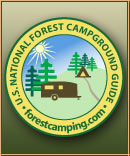Forest Information
Gallatin National Forest is located in southwestern Montana and is comprised of 1,790,227 acres. There are thirty-four developed campgrounds of which twenty-four meet the selection criteria.
Within the Gallatin National Forest are some of the most rugged mountains and pristine wilderness to be found in Montana. To the northern side of the Forest, in isolated blocks, are the Bridger and Crazy mountains. On the western side are the Madison and Gallatin mountains. And to the east are Absaroka and Beartooth ranges. The spectacular views of these rugged mountains have inspired mystical reverence in some and a sense of awe in all.
While the mountains inspire and amaze, they also provide the Gallatin National Forest's visitor numerous outstanding recreational opportunities and some of the most spectacular camping locations. With some where around 2,000-miles of hiking and riding trails, visitors can find a trail to meet their needs and abilities. The Lee Metcalf and Absaroka-Beartooth Wilderness areas provide Gallatin visitors an excellent opportunity experience the natural Montana. The Madison, Gallatin, and Yellowstone rivers have Class One trout fishing for the angler and whitewater canoeing, kayaking, and rafting. (Check with the Ranger District Offices for conditions and outfitters.)
The developed camping locations of the Gallatin National Forest provide visitors with an excellent opportunity to enjoy the beauty and wonders of this forest. Some, such as Eagle Creek, Colter, and Baker's Hole, are conveniently located to Yellowstone National Park. These campgrounds, with their quiet, spacious sites, provide an alternative to the Park's campgrounds. While all three of these camping locations can accommodate car, tent, recreational vehicle (RV) and motorhome camping enthusiasts, Eagle Creek and Colter are best suited for car and tent campers. Located right on the Madison River, Baker's Hole is possibly the most RV and motorhome-friendly campground in the Gallatin and a popular family camping vacation spot.
For a wilderness experience, with the convenience of vault bathrooms and running water, there are Hick's Park, Tom Miner, and Rainbow Point. The Hick's Park campground is tucked into Boulder Canyon with a tranquil feel. Camping at Tom Miner requires a long drive to heavily wooded valley. One of the Gallatin's many points of interest is Hebgen Reservoir, Rainbow Point provides easy to the Reservoir's great fishing and water play opportunities.
If exploration of the area's geological diversity is more to your interest, try Red Cliff or Spire Rock campgrounds. For birding and wildlife viewing none can beat Beaver Creek campgrounds.
Winter offers a whole different spectrum of recreational opportunities. Cross-country ski and snowmobile trails viewed in the summer provide just a hint of the pleasure these activities can bring to a Gallatin visitor in the winter-time.
The Gallatin National Forest touches Yellowstone National Park on two sides. Because of this, the Gallatin shares two elements of the Park: abundant wildlife and a dynamic geology. Running through the western side of the Gallatin are many fault-lines produced by the world's largest thermal basin. An example of this relationship is located near West Yellowstone, Montana and is called Earthquake Lake. Formed by a deadly landslide, the result of a 7.5 earthquake, on August 17, 1959, Earthquake Lake is powerful proof of the area's activity, past, present, and future.
There are specific areas within the Forest set aside for some of the species of big game, such as Bighorn sheep, elk, and grizzly bear, who often travel between the Park and Forest. While the sight of any wildlife is exciting, remember these are beautiful but wild animals. Treat them with respect and distance.
One other activity that is hugely popular in the Gallatin National Forest, particularly in both the Lee Metcalf and Absaroka-Beartooth Wildernesses, is dispersed camping. This is camping in an undeveloped location where the camper is completely on their own. Because it is undeveloped dispersed camping locations are not included in this campground review. Contact the Gallatin National Forest for the rules and regulations of dispersed camping.
In the mid-1800's people came to the area now called the Gallatin National Forest for gold and wealth untold. Today, the Gallatin National Forest gives its visitors a wealth of sights, sounds, and smells: the sharp tang of pine on the cool morning fog; coyotes yipping at sunset; and, cloud-catching mountains. This and more are awaiting visitors to the Gallatin National Forest.
ADDRESSES
SUPERVISOR ADDRESS
P.O. Box 130
10 E. Babcock Ave.
Bozeman, Montana 59771
406-587-6701
RANGER DISTRICT ADDRESSES
Bozeman
3710 Fallon St.
Suite C
Bozeman, Montana 59718
406-522-2520
Gardiner
P.O. Box 5
805 Scott St.
Gardiner, Montana 59030
406-848-7375
Hebgen Lake
P.O. Box 520
330 Gallatin Rd.
West Yellowstone, Montana 59758
406-823-6961
Yellowstone
5242 Hwy. 89 South
Livingston, Montana 59047
406-222-1892 |
